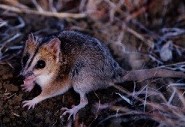 The Julia Creek dunnart (Sminthopsis douglasi) shares two features with the vastly different kangaroo – both are marsupials. Instead of developing in a womb, the babies develop in a pouch. Both creatures live in Australia. Unlike the kangaroo, the Julia Creek dunnart is considered endangered under Australian law. Its habitat has been restricted to a small Northeastern portion of Australia called the Mitchell Grass Downs, where a Julia Creek resides. This is an arid environment.
The Julia Creek dunnart (Sminthopsis douglasi) shares two features with the vastly different kangaroo – both are marsupials. Instead of developing in a womb, the babies develop in a pouch. Both creatures live in Australia. Unlike the kangaroo, the Julia Creek dunnart is considered endangered under Australian law. Its habitat has been restricted to a small Northeastern portion of Australia called the Mitchell Grass Downs, where a Julia Creek resides. This is an arid environment.The Julia Creek dunnart was almost wiped out before it was discovered in the 1930. The species was thought to have been wiped out by invasive species such as the European fox and the domestic cat until it was rediscovered in 1992. Populations have risen slightly since then as Australia has begun exterminating stray cats. The Julia Creek dunnart is still prey for dingos.
General Description
This little marsupial strongly resembles a mouse, with tiny pink paws and a long, naked tail. Its coat is a light sandy brown with a dark stripe running from the tip of the nose down the spine. The dark eyes are large in comparison to the rest of the head. The belly, chest and inside of the legs are white.
Adults weigh in between 1.41 to 2.47 ounces (40 to 70 grams) and reach a nose to tail length of 6.
Life Cycle and Behavior
After a gestation of a mere 12 days, the females expel the pink embryos, which crawl from the vagina to the pouch. The embryos are so undeveloped that they do not have lungs and absorb oxygen through their skin. A female can have up to eight babies or joeys at a time. Julia Creek dunnarts begin hunting when they are only 10 weeks old. Julia Creek dunnarts live in family colonies and enjoy each other’s company.
Julia Creek dunnarts can take down lizards and mice nearly twice their size. They also hunt spiders and insects. They rarely need to drink because their prey contains the moisture they need. They make their homes deep in crevices in the ground during the day and come up at night to hunt. They can go into a hibernation-like state in order to survive times of famine.
Picture of the Julia Creek Dunnart by ZooPro, licensed under the Creative Commons Attribution-Share Alike 3.0 Unported license.
Keywords: brown , white , tail , stripe
The Julia creek dunnart is listed as Endangered (EN), considered to be facing a very high risk of extinction in the wild, on the IUCN Red List of Threatened Species
Countries
AustraliaSome facts about the
Julia Creek dunnart
Adult weight : 0.055 kg (0.121 lbs)

Custom Search